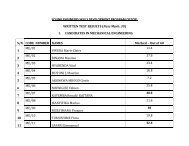lois et reglements police de roulage avec amendements
lois et reglements police de roulage avec amendements
lois et reglements police de roulage avec amendements
Create successful ePaper yourself
Turn your PDF publications into a flip-book with our unique Google optimized e-Paper software.
light.<br />
2. A line constituted by white isosceles triangles the apex of which are directed towards the<br />
drivers concerned and drawn perpendicularly to the bor<strong>de</strong>r of the roadway indicates the spot<br />
where drivers must, if necessary, stop in or<strong>de</strong>r to give way in accordance with signal n° B, I (<br />
triangle one apex of which is downwards).<br />
3. Pe<strong>de</strong>strians' crossings are <strong>de</strong>limited by white lines parallel to the roadway.<br />
4. Lanes to be used by two wheeled bicycles and mobyl<strong>et</strong>tes for crossing the roadway are<br />
<strong>de</strong>limited by two discontinued lines constituted by white squares or parallelograms.<br />
5. Transversal white lines must be 0,20 to 0,60 m<strong>et</strong>re wi<strong>de</strong>. The sizes of the white squares must<br />
be 0,40 m to 0,60 m long.<br />
The base of white triangles and parallelograms must be 0,40 m to 0,60 m wi<strong>de</strong> and 0,50 m to<br />
0,70 m high.<br />
Section 3. Other marks<br />
Article 112:<br />
1. White selection arrows may be drawn on approach of a junction.<br />
These marks indicate the traffic lane that drivers must follow to turn into the way shown by<br />
respective arrows.<br />
In addition, at a junction, drivers must follow one of the directions indicated on the traffic lane<br />
on which they are.<br />
2. The broken line which announces the approach of a continuous line may be compl<strong>et</strong>ed by<br />
white fall back arrows.<br />
These marks announce the reduction of the number of traffic lanes which may be used in the<br />
direction followed.<br />
3. Inscriptions in white colour on the roadway may be compl<strong>et</strong>ed by indications given by traffic<br />
signals.<br />
4. The various directions may be shown on the respective traffic lanes.<br />
5. At common transport vehicles stopping places the areas where it is forbid<strong>de</strong>n to park in<br />
application of Article 33, 3g, may be indicated by inscriptions in white.<br />
6. The arrows and l<strong>et</strong>ters of the inscriptions must at least go to 2,50 m long, except in places<br />
where approach speeds do not exceed 50 kms per hour and the width of their strokes must be<br />
0,10 to 0,30 m<strong>et</strong>re.<br />
7. Spaces where vehicles traffic is prohibited or where vehicles are obliged to follow a<br />
d<strong>et</strong>ermined direction may be materialised on the ground by white oblique lines, of 0,10 to 0.,5<br />
m wi<strong>de</strong> and distant b<strong>et</strong>ween 0,20 to 0,30 m.<br />
Chapter 5. SIGNALLING OF WORK SITES AND OBSTACLES<br />
Article 113:<br />
1. Signalling work sites on the public highway is the responsibility of the person conducting the<br />
works.<br />
Whenever it is necessary to use signals relating to priority, prohibition, obligation, stopping,<br />
parking or provisional longitudinal marks indicating circulation lanes, these signals are placed<br />
only after being authorised by the Prefect or his <strong>de</strong>legate.<br />
This authorisation d<strong>et</strong>ermines in each case the signals to be used.




